Yannis Panagakis
A Principled Framework for Multi-View Contrastive Learning
Jul 09, 2025Abstract:Contrastive Learning (CL), a leading paradigm in Self-Supervised Learning (SSL), typically relies on pairs of data views generated through augmentation. While multiple augmentations per instance (more than two) improve generalization in supervised learning, current CL methods handle additional views suboptimally by simply aggregating different pairwise objectives. This approach suffers from four critical limitations: (L1) it utilizes multiple optimization terms per data point resulting to conflicting objectives, (L2) it fails to model all interactions across views and data points, (L3) it inherits fundamental limitations (e.g. alignment-uniformity coupling) from pairwise CL losses, and (L4) it prevents fully realizing the benefits of increased view multiplicity observed in supervised settings. We address these limitations through two novel loss functions: MV-InfoNCE, which extends InfoNCE to incorporate all possible view interactions simultaneously in one term per data point, and MV-DHEL, which decouples alignment from uniformity across views while scaling interaction complexity with view multiplicity. Both approaches are theoretically grounded - we prove they asymptotically optimize for alignment of all views and uniformity, providing principled extensions to multi-view contrastive learning. Our empirical results on ImageNet1K and three other datasets demonstrate that our methods consistently outperform existing multi-view approaches and effectively scale with increasing view multiplicity. We also apply our objectives to multimodal data and show that, in contrast to other contrastive objectives, they can scale beyond just two modalities. Most significantly, ablation studies reveal that MV-DHEL with five or more views effectively mitigates dimensionality collapse by fully utilizing the embedding space, thereby delivering multi-view benefits observed in supervised learning.
Are Large Brainwave Foundation Models Capable Yet? Insights from Fine-tuning
Jul 01, 2025Abstract:Foundation Models have demonstrated significant success across various domains in Artificial Intelligence (AI), yet their capabilities for brainwave modeling remain unclear. In this paper, we comprehensively evaluate current Large Brainwave Foundation Models (LBMs) through systematic fine-tuning experiments across multiple Brain-Computer Interface (BCI) benchmark tasks, including memory tasks and sleep stage classification. Our extensive analysis shows that state-of-the-art LBMs achieve only marginal improvements (0.9%-1.2%) over traditional deep architectures while requiring significantly more parameters (millions vs thousands), raising important questions about their efficiency and applicability in BCI contexts. Moreover, through detailed ablation studies and Low-Rank Adaptation (LoRA), we significantly reduce trainable parameters without performance degradation, while demonstrating that architectural and training inefficiencies limit LBMs' current capabilities. Our experiments span both full model fine-tuning and parameter-efficient adaptation techniques, providing insights into optimal training strategies for BCI applications. We pioneer the application of LoRA to LBMs, revealing that performance benefits generally emerge when adapting multiple neural network components simultaneously. These findings highlight the critical need for domain-specific development strategies to advance LBMs, suggesting that current architectures may require redesign to fully leverage the potential of foundation models in brainwave analysis.
Causally Steered Diffusion for Automated Video Counterfactual Generation
Jun 17, 2025Abstract:Adapting text-to-image (T2I) latent diffusion models for video editing has shown strong visual fidelity and controllability, but challenges remain in maintaining causal relationships in video content. Edits affecting causally dependent attributes risk generating unrealistic or misleading outcomes if these relationships are ignored. In this work, we propose a causally faithful framework for counterfactual video generation, guided by a vision-language model (VLM). Our method is agnostic to the underlying video editing system and does not require access to its internal mechanisms or finetuning. Instead, we guide the generation by optimizing text prompts based on an assumed causal graph, addressing the challenge of latent space control in LDMs. We evaluate our approach using standard video quality metrics and counterfactual-specific criteria, such as causal effectiveness and minimality. Our results demonstrate that causally faithful video counterfactuals can be effectively generated within the learned distribution of LDMs through prompt-based causal steering. With its compatibility with any black-box video editing system, our method holds significant potential for generating realistic "what-if" video scenarios in diverse areas such as healthcare and digital media.
Advancing Brainwave Modeling with a Codebook-Based Foundation Model
May 22, 2025Abstract:Recent advances in large-scale pre-trained Electroencephalogram (EEG) models have shown great promise, driving progress in Brain-Computer Interfaces (BCIs) and healthcare applications. However, despite their success, many existing pre-trained models have struggled to fully capture the rich information content of neural oscillations, a limitation that fundamentally constrains their performance and generalizability across diverse BCI tasks. This limitation is frequently rooted in suboptimal architectural design choices which constrain their representational capacity. In this work, we introduce LaBraM++, an enhanced Large Brainwave Foundation Model (LBM) that incorporates principled improvements grounded in robust signal processing foundations. LaBraM++ demonstrates substantial gains across a variety of tasks, consistently outperforming its originally-based architecture and achieving competitive results when compared to other open-source LBMs. Its superior performance and training efficiency highlight its potential as a strong foundation for future advancements in LBMs.
Enabling Local Editing in Diffusion Models by Joint and Individual Component Analysis
Sep 02, 2024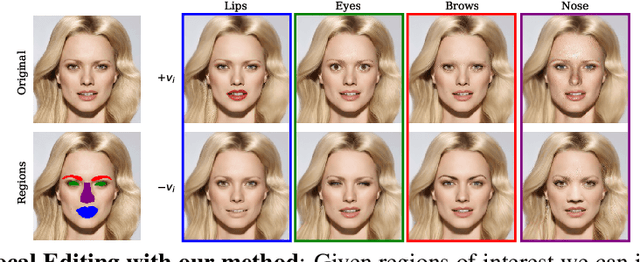



Abstract:Recent advances in Diffusion Models (DMs) have led to significant progress in visual synthesis and editing tasks, establishing them as a strong competitor to Generative Adversarial Networks (GANs). However, the latent space of DMs is not as well understood as that of GANs. Recent research has focused on unsupervised semantic discovery in the latent space of DMs by leveraging the bottleneck layer of the denoising network, which has been shown to exhibit properties of a semantic latent space. However, these approaches are limited to discovering global attributes. In this paper we address, the challenge of local image manipulation in DMs and introduce an unsupervised method to factorize the latent semantics learned by the denoising network of pre-trained DMs. Given an arbitrary image and defined regions of interest, we utilize the Jacobian of the denoising network to establish a relation between the regions of interest and their corresponding subspaces in the latent space. Furthermore, we disentangle the joint and individual components of these subspaces to identify latent directions that enable local image manipulation. Once discovered, these directions can be applied to different images to produce semantically consistent edits, making our method suitable for practical applications. Experimental results on various datasets demonstrate that our method can produce semantic edits that are more localized and have better fidelity compared to the state-of-the-art.
Scale Equivariant Graph Metanetworks
Jun 15, 2024
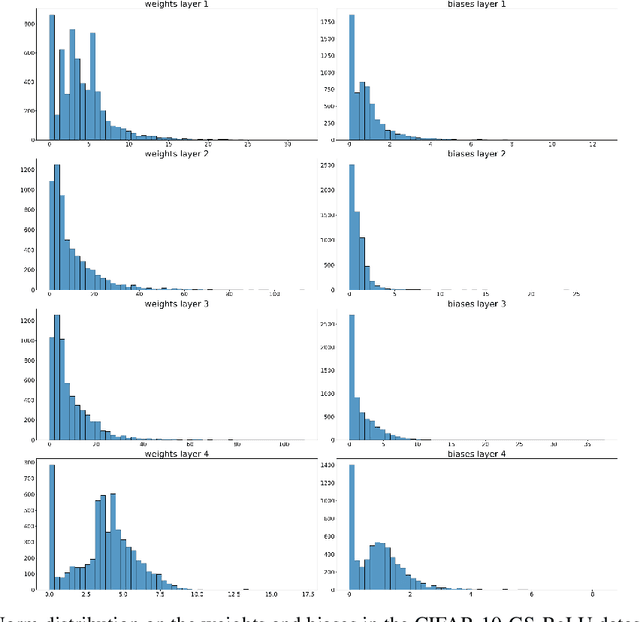

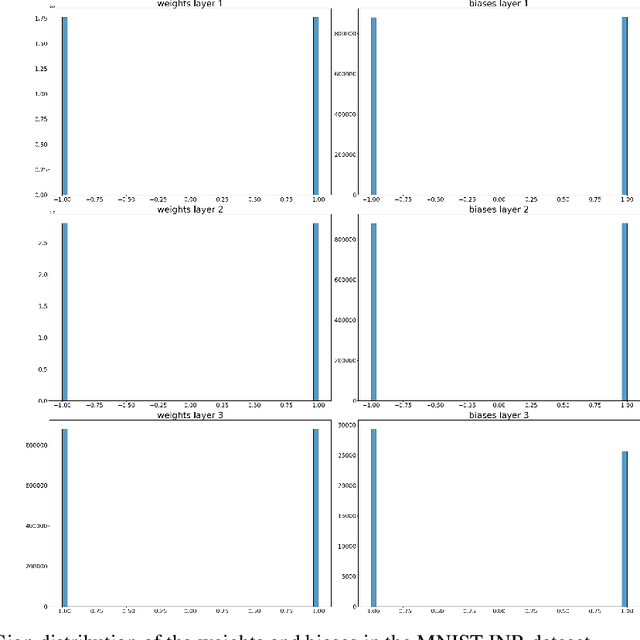
Abstract:This paper pertains to an emerging machine learning paradigm: learning higher-order functions, i.e. functions whose inputs are functions themselves, $\textit{particularly when these inputs are Neural Networks (NNs)}$. With the growing interest in architectures that process NNs, a recurring design principle has permeated the field: adhering to the permutation symmetries arising from the connectionist structure of NNs. $\textit{However, are these the sole symmetries present in NN parameterizations}$? Zooming into most practical activation functions (e.g. sine, ReLU, tanh) answers this question negatively and gives rise to intriguing new symmetries, which we collectively refer to as $\textit{scaling symmetries}$, that is, non-zero scalar multiplications and divisions of weights and biases. In this work, we propose $\textit{Scale Equivariant Graph MetaNetworks - ScaleGMNs}$, a framework that adapts the Graph Metanetwork (message-passing) paradigm by incorporating scaling symmetries and thus rendering neuron and edge representations equivariant to valid scalings. We introduce novel building blocks, of independent technical interest, that allow for equivariance or invariance with respect to individual scalar multipliers or their product and use them in all components of ScaleGMN. Furthermore, we prove that, under certain expressivity conditions, ScaleGMN can simulate the forward and backward pass of any input feedforward neural network. Experimental results demonstrate that our method advances the state-of-the-art performance for several datasets and activation functions, highlighting the power of scaling symmetries as an inductive bias for NN processing.
Bridging Mini-Batch and Asymptotic Analysis in Contrastive Learning: From InfoNCE to Kernel-Based Losses
May 28, 2024



Abstract:What do different contrastive learning (CL) losses actually optimize for? Although multiple CL methods have demonstrated remarkable representation learning capabilities, the differences in their inner workings remain largely opaque. In this work, we analyse several CL families and prove that, under certain conditions, they admit the same minimisers when optimizing either their batch-level objectives or their expectations asymptotically. In both cases, an intimate connection with the hyperspherical energy minimisation (HEM) problem resurfaces. Drawing inspiration from this, we introduce a novel CL objective, coined Decoupled Hyperspherical Energy Loss (DHEL). DHEL simplifies the problem by decoupling the target hyperspherical energy from the alignment of positive examples while preserving the same theoretical guarantees. Going one step further, we show the same results hold for another relevant CL family, namely kernel contrastive learning (KCL), with the additional advantage of the expected loss being independent of batch size, thus identifying the minimisers in the non-asymptotic regime. Empirical results demonstrate improved downstream performance and robustness across combinations of different batch sizes and hyperparameters and reduced dimensionality collapse, on several computer vision datasets.
Multilinear Mixture of Experts: Scalable Expert Specialization through Factorization
Feb 19, 2024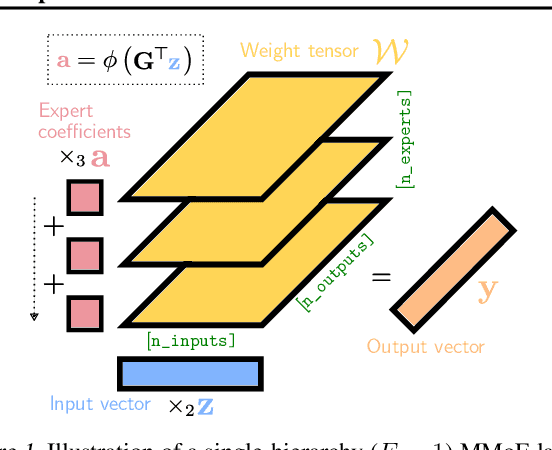



Abstract:The Mixture of Experts (MoE) paradigm provides a powerful way to decompose inscrutable dense layers into smaller, modular computations often more amenable to human interpretation, debugging, and editability. A major problem however lies in the computational cost of scaling the number of experts to achieve sufficiently fine-grained specialization. In this paper, we propose the Multilinear Mixutre of Experts (MMoE) layer to address this, focusing on vision models. MMoE layers perform an implicit computation on prohibitively large weight tensors entirely in factorized form. Consequently, MMoEs both (1) avoid the issues incurred through the discrete expert routing in the popular 'sparse' MoE models, yet (2) do not incur the restrictively high inference-time costs of 'soft' MoE alternatives. We present both qualitative and quantitative evidence (through visualization and counterfactual interventions respectively) that scaling MMoE layers when fine-tuning foundation models for vision tasks leads to more specialized experts at the class-level whilst remaining competitive with the performance of parameter-matched linear layer counterparts. Finally, we show that learned expert specialism further facilitates manual correction of demographic bias in CelebA attribute classification. Our MMoE model code is available at https://github.com/james-oldfield/MMoE.
Latent Alignment with Deep Set EEG Decoders
Nov 29, 2023
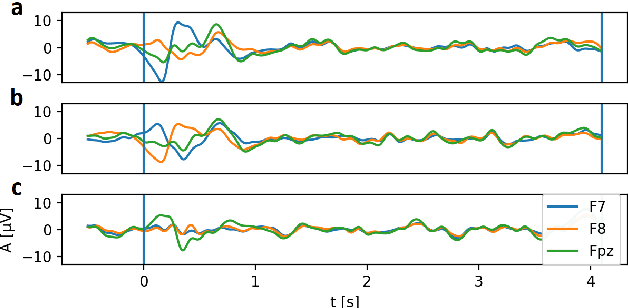


Abstract:The variability in EEG signals between different individuals poses a significant challenge when implementing brain-computer interfaces (BCI). Commonly proposed solutions to this problem include deep learning models, due to their increased capacity and generalization, as well as explicit domain adaptation techniques. Here, we introduce the Latent Alignment method that won the Benchmarks for EEG Transfer Learning (BEETL) competition and present its formulation as a deep set applied on the set of trials from a given subject. Its performance is compared to recent statistical domain adaptation techniques under various conditions. The experimental paradigms include motor imagery (MI), oddball event-related potentials (ERP) and sleep stage classification, where different well-established deep learning models are applied on each task. Our experimental results show that performing statistical distribution alignment at later stages in a deep learning model is beneficial to the classification accuracy, yielding the highest performance for our proposed method. We further investigate practical considerations that arise in the context of using deep learning and statistical alignment for EEG decoding. In this regard, we study class-discriminative artifacts that can spuriously improve results for deep learning models, as well as the impact of class-imbalance on alignment. We delineate a trade-off relationship between increased classification accuracy when alignment is performed at later modeling stages, and susceptibility to class-imbalance in the set of trials that the statistics are computed on.
Locality-preserving Directions for Interpreting the Latent Space of Satellite Image GANs
Sep 26, 2023Abstract:We present a locality-aware method for interpreting the latent space of wavelet-based Generative Adversarial Networks (GANs), that can well capture the large spatial and spectral variability that is characteristic to satellite imagery. By focusing on preserving locality, the proposed method is able to decompose the weight-space of pre-trained GANs and recover interpretable directions that correspond to high-level semantic concepts (such as urbanization, structure density, flora presence) - that can subsequently be used for guided synthesis of satellite imagery. In contrast to typically used approaches that focus on capturing the variability of the weight-space in a reduced dimensionality space (i.e., based on Principal Component Analysis, PCA), we show that preserving locality leads to vectors with different angles, that are more robust to artifacts and can better preserve class information. Via a set of quantitative and qualitative examples, we further show that the proposed approach can outperform both baseline geometric augmentations, as well as global, PCA-based approaches for data synthesis in the context of data augmentation for satellite scene classification.
 Add to Chrome
Add to Chrome Add to Firefox
Add to Firefox Add to Edge
Add to Edge